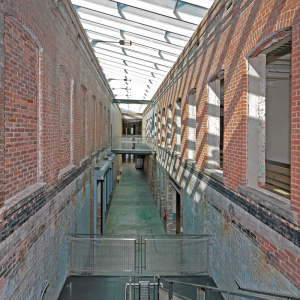Gilbane has completed several projects within historic landmarks and understands the unique challenges associated with creating code-compliant, modern-use facilities that support technological advancement, while also maintaining the structures as physical records of a time and place long since passed.

Protecting the Historic Design Integrity
Critical planning and deliberate design helps support preservation efforts when building within protected buildings. To retain historic integrity and character, Gilbane project teams must rely on the extensive use of salvaged materials; century-old bricks are removed, carefully cleaned and reused, while original wooden floor boards are revitalized and cleaned. Structural features that may have deteriorated over time, or have been altered by modern tenants, are repaired and restored as critical aesthetic components to the project, rather than replaced.
Updates to Existing Infrastructure
As historic buildings are repurposed, structural and utility upgrades are required. Seamless coordination with subcontractors is imperative to ensure the installation of building systems has minimal effect on the integrity of the structure. Often, modern equipment exceeds the weight threshold for antiquated structures or is larger than the width of original doorways. In these instances, project teams must oversee the work of specialty contractors as they remove and replace walls or reinforce floors without causing damage to historic materials or character.
Working Within an Occupied Facility
Despite their age, many historic buildings have remained occupied use since their original construction. In addition to planning for the physical changes to the site, a detailed construction plan must be developed to ensure construction activities have zero interference with daily operations, work to regulate noise, dust, vibrations and environmental controls, as well as mitigate potential impacts to the surrounding community.
Massachusetts Museum of Contemporary Arts (MASS MoCA)
Built in North Adams, Massachusetts in 1860, the 26-building complex that the MASS MoCA has called home since 1999 was originally used as a textile mill which prospered throughout the Civil War by providing the Union Army with uniforms. The complex was added to the NRHP in 1985 for its historic significance.
In 2017, MASS MoCA and Gilbane completed the third phase of a comprehensive 25-year master plan for the redevelopment of the mill complex, which included the build-out of 135,00 SF of interior space, making it one of the largest museums for contemporary art in the country.
Click here to learn more about this award-winning project with deep ties to the community.
This project was recently named a Gold Award winner in Building Design + Construction’s 35th Annual Reconstruction Awards program.

